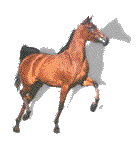An intro to breeding, more to come...

SEASONAL AFFECTS ON REPRODUCTION
For the next few weeks we will be discussing reproduction. It certainly is one of my favorite subjects and there are many differents topics we can discuss. We will discuss breeding the open mare, breeding the mare with a foal by side, breeding the two year old filly, and even giving the stallion a little time. If there are additional topics in reproduction you would like to have discussed, please let us know.
The mares coming through winter without being pregnant are starting to cycle with a great deal of enthusiasm. The days are becoming longer and their influence is reaching its peak. The never-ending heat activity of the transitional period is about over. The mares should be showing signs of heat for about five days and doing so every twenty one days. It is only when they are having regular cycles that they will have a good chance of becoming pregnant.
The mare left open all winter should have her  uterus cultured for bacterial growth. The open mare is at great risk of contamination from stool-borne bacteria. If she is in her teenage years, the ability of her uterus to clean up this bacteria is starting to decrease. The degree of infection will determine where the process of becoming pregnant can be interrupted.
uterus cultured for bacterial growth. The open mare is at great risk of contamination from stool-borne bacteria. If she is in her teenage years, the ability of her uterus to clean up this bacteria is starting to decrease. The degree of infection will determine where the process of becoming pregnant can be interrupted.
If large numbers of bacteria are present during the breeding process, they and their by-products will kill the sperm cells as they travel through the uterus on the way to their destination: the ovaries. With a moderate infection, the sperm may make their way to the oviduct (the meeting place for the egg and sperm). But when the embryo drops down into the uterus five days later, it will find a contaminated environment and be killed! With a very light infection or one deep in the uterine tissue, the embryo may survive as long as it is free floating. However, along about the third week, when the embryo starts to attach itself to the uterine tissue, the embryo will make contact with the deep infection. This is one of several reasons some mares will be found pregnant by ultrasound or will pass thru the first heat without showing signs, and still end up not pregnant.
Once a culture is taken and no growth is found, the mare can be bred when she is in heat. As we mentioned earlier, the "average mare" will stay in heat five days; but who of that gender ever wanted to be average...? The better you know your mare and the closer contact you have with her, the longer you may find her heats to be. The intensity of the heat signs will build for several days, with the “hottest” day being the day of ovulation. Ovulation is 36 hours before the end of heat. Immediately, we will notice a change in the reproductive tract and you will often notice a change in the mare’s personality: in the mare’s thinking, there is no reason to breed after ovulation. So if her attitude suddenly changes on the fourth day of heat, the effort to breed her the next day is wasted.
With the use of ultrasound, we can pregnancy check the mare after day fourteen. One advantage of using this method of pregnancy exam is to evaluate the mare before the date of her next heat so you can make plans to take appropriate actions.
[Remember, each year that she "misses" a heat will make her foaling one month later in the season throughout the rest of her reproductive lifespan, unless she takes an "open" year, which is also unproductive to horse breeders: try to avoid getting into this cycle by doing early pregnancy checks]
Should she not be pregnant, plans can be made to take her to the stallion.
If she is pregnant, the two of you can celebrate.
the two of you can celebrate.
CLICK BELOW TO DISPLAY A PRINTER-FRIENDLY COPY OF THIS ARTICLE
Select "Open this file from its current location," if you just want to print it out,
it will open in a simple word processing application, select the print button.
(unless you want to save this article in your computer's memory)

 IntroToBreeding.rtf
IntroToBreeding.rtf